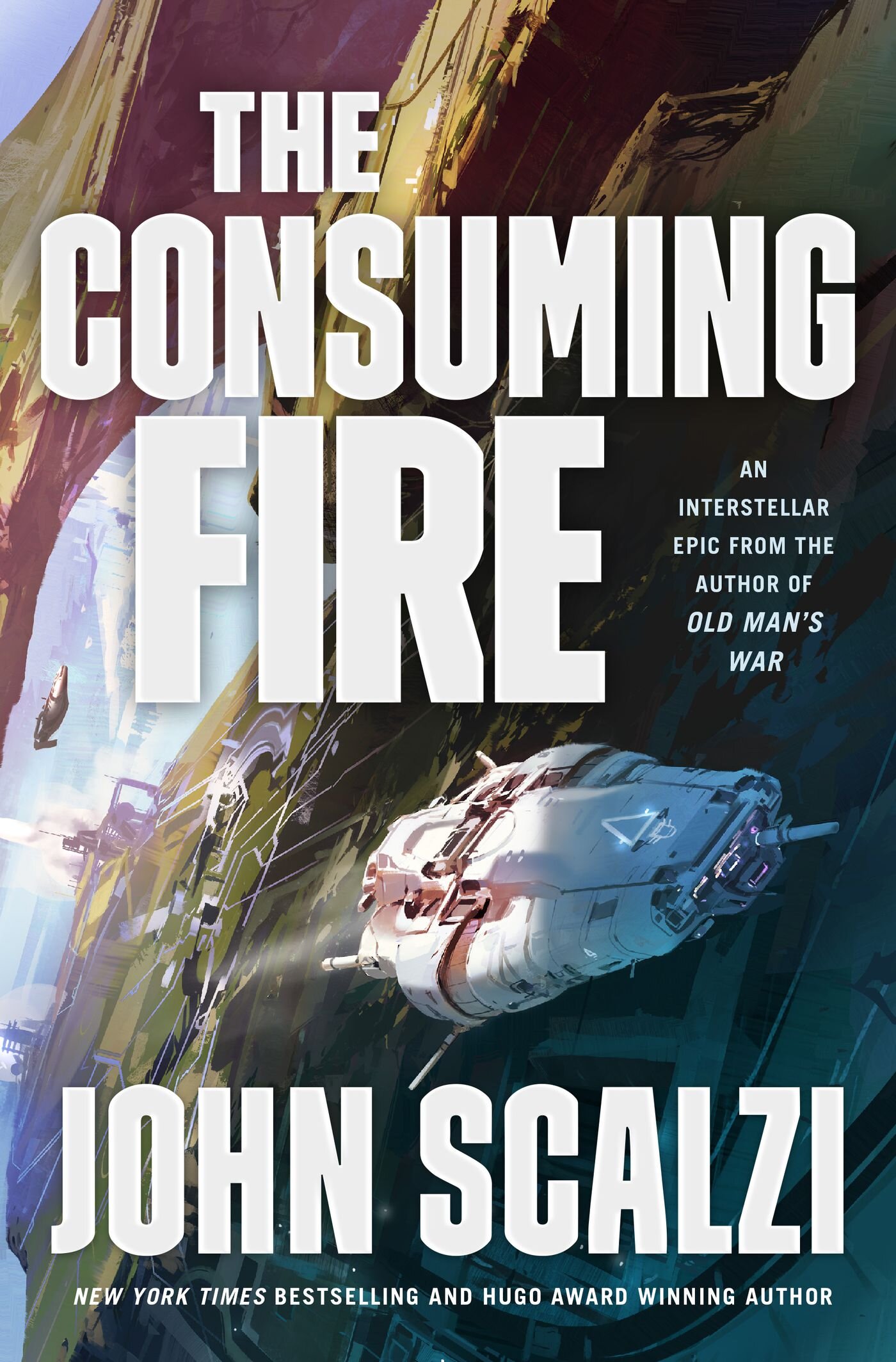Book Review: The Consuming Fire
I started rereading The Consuming Fire to get prepared for The Last Emperox, and I promptly realized that it came out during my hiatus. So here we are, putting up a review so there will be a nice, complete set for the Interdependency series.
Not everyone believes that the Flow streams are collapsing yet, but it’s only a matter of time. Emperox Grayland II, in a move calculated to save the Interdependency, begins to have visions to force society into action. Meanwhile, Lord Marce Claremont investigates what happened to the only known system to be cut off before, and makes a startling discovery (or two). And behind all this, the dastardly Nohamepetans plot the death of the emperox, with some new allies.
One of the things I appreciate most about Scalzi’s writing is how accessible it is. i don’t have to work to enjoy his books; I can just disengage and let go. It’s truly a relaxing experience, on the whole. That’s on top of his general sarcastic tone as narrator, which really works for me in this series. Taken together, both qualities make The Consuming Fire feel breezy and fun. It’s a quick read, and that’s not just because it’s a fairly short book. It just moves well, even though most of the “action” (and even the climax) are political maneuvering. Making business meetings sound fun and exciting can’t be easy, but Scalzi pulls it off with aplomb here.
Another major part of why I enjoy the Interdependency books is the characters. All of our favorites from The Collapsing Empire are back here: Cardenia/Grayland II, the put-upon emperox who just wants to save her people and has somehow managed to be more of a threat than people give her credit for; Kiva, who accidentally swears and fucks her way into a position of power and who’s just a goddamn joy to read; and Marce, our sweet cinnamon roll of a scientist. Each of them has their own, clearly delineated section of the plot, all of which dovetail together nicely. And unlike before, where Kiva and Marce spent most of the book en route to Hub, here all three are in fairly close proximity and get the chance to interact more. Cardenia and Kiva develop a healthy respect and working relationship, while Marce and Cardenia’s working relationship turns decidedly romantic.
Of course, it’s not all sunshine and roses. The villains are back too. Nadashe Nohamepetan spent most of The Collapsing Empire as the architect behind the scenes, her appearances few and far between. That changes here as she becomes a viewpoint character and we get to see inside her head. It’s…not pretty. On top of Nadashe, we also get her mother, who’s just as conniving and backstabbing. It’s honestly pretty disgusting the lengths to which the Nohamepetans will go to increase their power, especially when Cardenia/Grayland II has done very little to wrong them. That makes them good villains, insofar as you’ll definitely dislike them, and they’re delusional enough to think they’re doing it for some form of the greater good.
Likewise, enter two of the emperox’s Wu cousins, both of whom believe they’d be better suited as emperox. Neither cousin is that well sketched out, other than generally being power-hungry, but they don’t need to be. Nadashe and her mother are the real villains here. The Wu cousins serve mainly to underscore the point that Cardenia lacks allies even in her own house.
Yet another part of what makes this series enjoyable is watching Scalzi play with fun ideas and interesting tech. Marce’s storyline, with its little side trip to Dalasysla, abandoned hundreds of years prior when its Flow streams collapsed, is the perfect example. Not only do we get to see how humanity has managed to tenaciously hang onto life despite the worst of hardships, but we also get a tangible sign of humanity outside the Interdependency. In a strange ship out there in Dalasysla, Marce meets Chenevert, a former king from a different section of humanity, transferred to the ship’s computer system and fled to avoid an uprising. (Of course, we have to take his word for that, and I’m curious to see how Chenevert plays out in the last book).
The other major idea in play? Not surprisingly, it’s what humanity does when the world ends. Shortly after this book begins, most of the skepticism from the first book is gone, and everyone is struggling to determine what to do — and how to deal with an emperox who’s having visions. The religion of the Interdependency is mainly a front to keep society together at the seams; it has little basis in the truly divine. So when Grayland starts talking about visions, there are some decisions to be made about how that religion can support the end of the world. Outside of that, practical solutions start to be tossed about here, things like martial law and evacuations to End, and they’re treated with varying degrees of seriousness.
There’s also worldbuilding here too, expanding on what we learned in The Collapsing Empire. Chenevert’s introduction prompts most of it; he informs Marce and Cardenia of the Rupture, the event that severed the Free Systems (now the Interdependency) from the rest of humanity and might also be responsible for the current Flow collapse. Cardenia, meanwhile, continues to learn about Rachela and the technology she has at her disposal in her Memory Room, with some rather startling finds.
All in all, The Consuming Fire is a good book, about as strong as the first one in the series — not mindblowingly, but a good, fun read and well worth your time if you enjoyed The Collapsing Empire.
4.25/5 stars
Memorable Quote:
“The Church of the Interdependency and other religions found their places of worship jammed, as the faithful, the newly faithful and the not-actually-at-all-faithful-but-this-is-some-weird-shit-and-I’m-hedging-my-bets came in and, depending on experience, prayed, meditated or wondered what it was exactly they were supposed to do now that they were there. Priests, ministers, rabbis, imams and other religious leaders were on one hand delighted to be useful in a moment of spiritual and existential crisis and on the other hand well aware that this was the theological equivalent of shoppers making a panic run at the market, with their new parishioners grabbing at anything and hoping it would get them through.”







